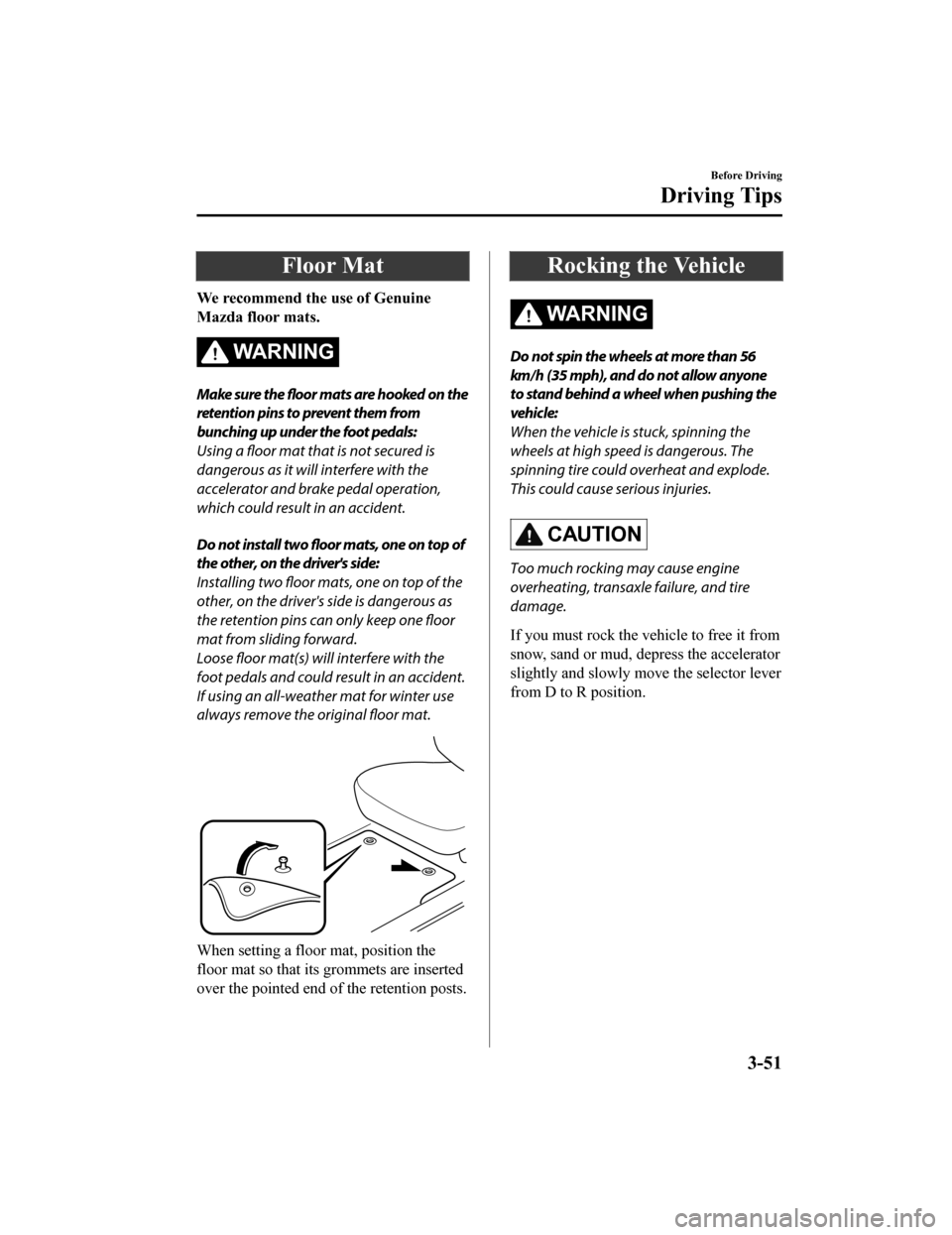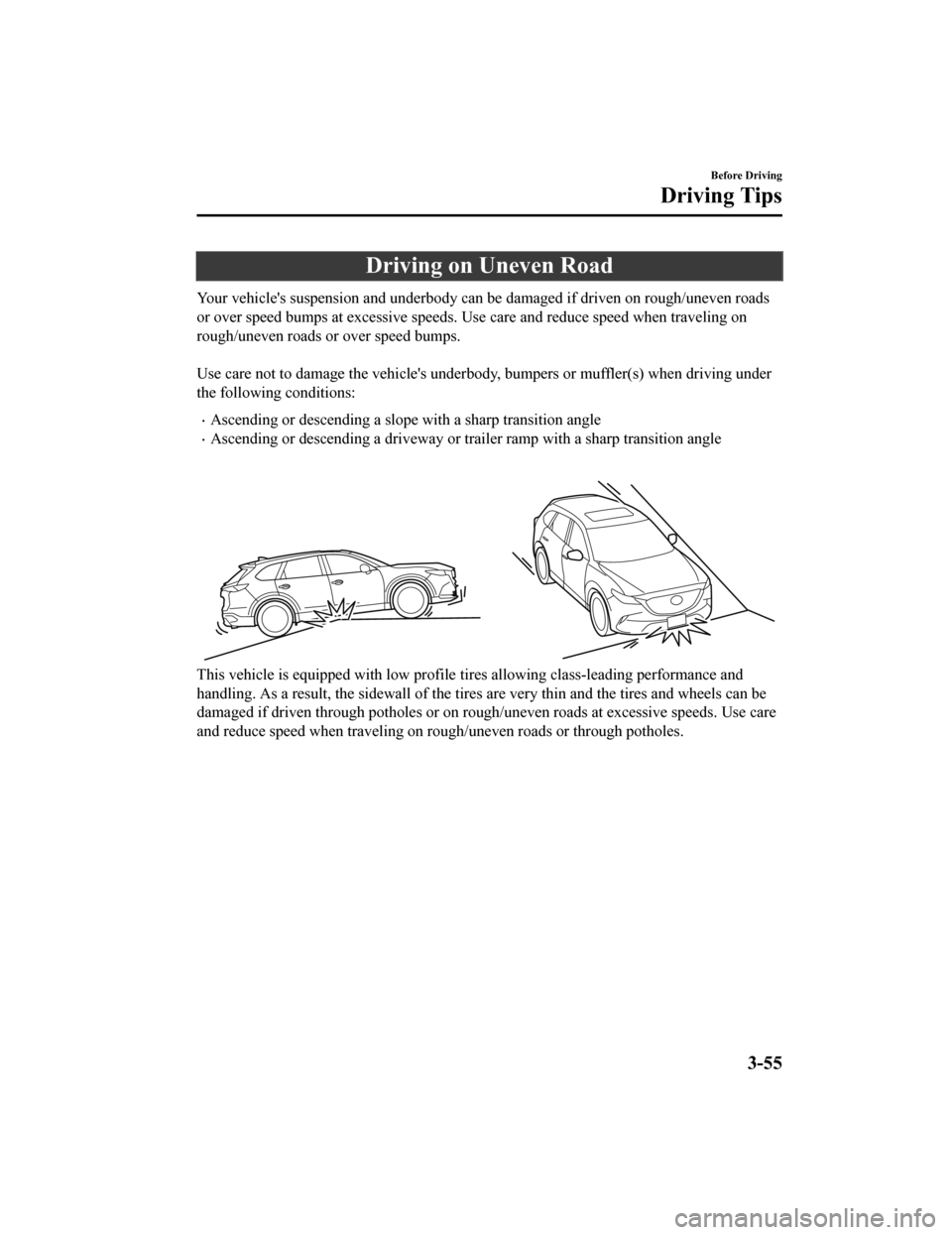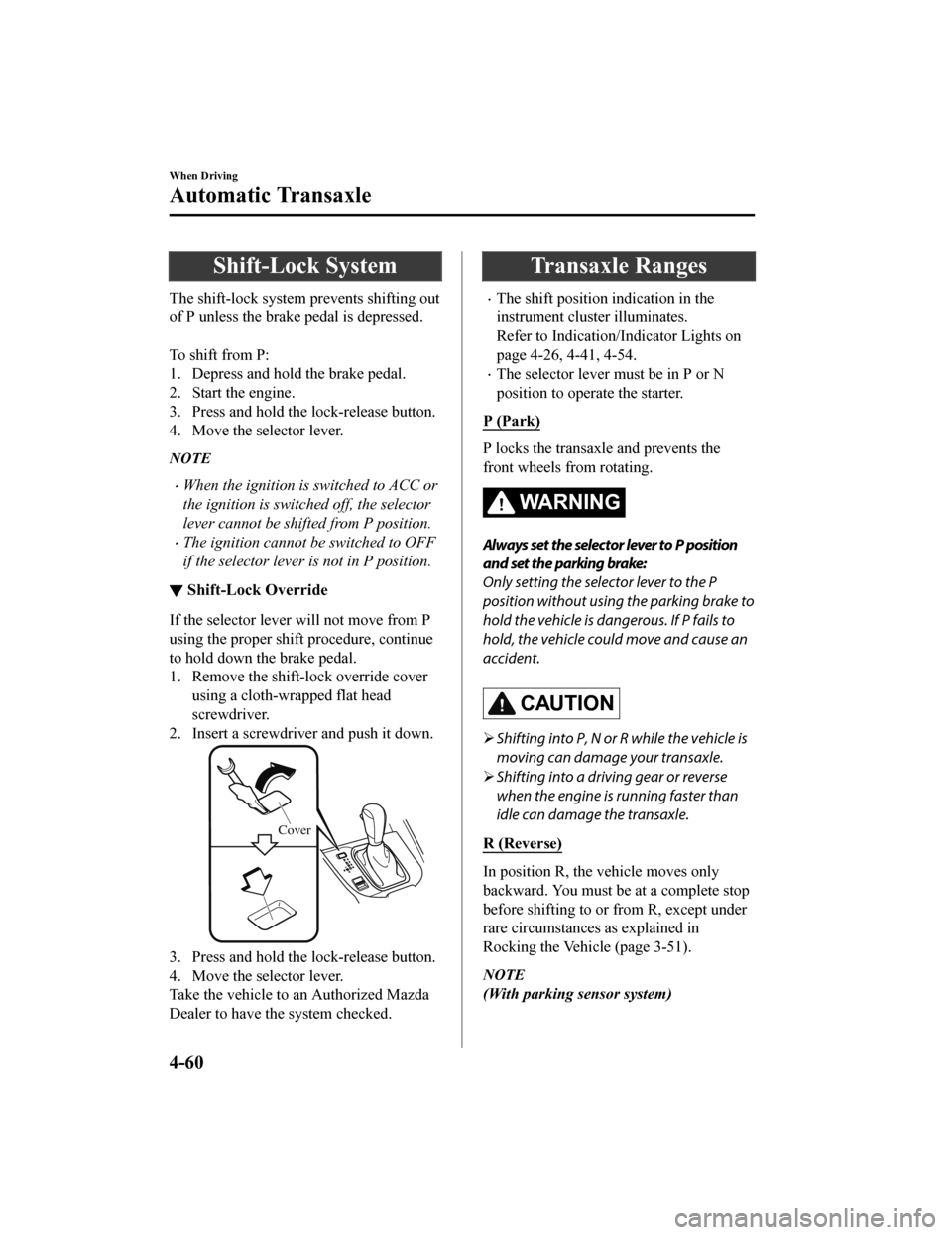wheel MAZDA MODEL CX-9 2020 (in English) Owner's Manual
[x] Cancel search | Manufacturer: MAZDA, Model Year: 2020, Model line: MODEL CX-9, Model: MAZDA MODEL CX-9 2020Pages: 706
Page 150 of 706

Hazardous Driving
WA R N I N G
Be extremely careful if it is necessary to
downshift on slippery surfaces:
Downshifting into lower gear while driving
on slippery surfaces is dangerous. The
sudden change in tire speed could cause
the tires to skid. This could lead to loss of
vehicle control and an accident.
Avoid sharp turns, excessive speed and
abrupt maneuvers when driving this
vehicle:
Sharp turns, excessive speed and abrupt
maneuvering of this vehicle are dangerous
as it could result in the increased risk of loss
of vehicle control, vehicle roll-over,
personal injury or death.
This vehicle has a higher center of gravity.
Vehicles with a higher center of gravity
such as utility vehicles handle differently
than vehicles with a lower center of gravity.
Utility vehicles are not designed for
cornering at high speeds any more than
low profile sports cars are designed to
perform satisfactorily under off-road
conditions.
In addition, utility vehicles have a
significantly higher rollover rate than other
types of vehicles.
In a rollover crash, an unbelted person is
significantly more likely to die than a
person wearing a seat belt.
When driving on ice or in water, snow,
mud, sand, or similar hazards:
Be cautious and allow extra distance for
braking.
Avoid sudden braking and sudden
maneuvering.
Do not pump the brakes. Continue to
press down on the brake pedal.
Refer to Antilock Brake System (ABS)
on page 4-99.
If you get stuck, select a lower gear and
accelerate slowly. Do not spin the front
wheels.
For more traction in starting on slippery
surfaces such as ice or packed snow, use
sand, rock salt, chains, carpeting, or
other nonslip material under the front
wheels.
NOTE
Use snow chains only on the front wheels.
Before Driving
Driving Tips
3-50
CX-9_8HT8-EA-19I_Edition2_old 2019-9-24 13:14:55
Page 151 of 706

Floor Mat
We recommend the use of Genuine
Mazda floor mats.
WA R N I N G
Make sure the floor mats are hooked on the
retention pins to prevent them from
bunching up under the foot pedals:
Using a floor mat that is not secured is
dangerous as it will interfere with the
accelerator and brake pedal operation,
which could result in an accident.
Do not install two floor mats, one on top of
the other, on the driver's side:
Installing two floor mats, one on top of the
other, on the driver's side is dangerous as
the retention pins can only keep one floor
mat from sliding forward.
Loose floor mat(s) will interfere with the
foot pedals and could result in an accident.
If using an all-weather mat for winter use
always remove the original floor mat.
When setting a floor mat, position the
floor mat so that its grommets are inserted
over the pointed end of the retention posts.
Rocking the Vehicle
WA R N I N G
Do not spin the wheels at more than 56
km/h (35 mph), and do not allow anyone
to stand behind a wheel when pushing the
vehicle:
When the vehicle is stuck, spinning the
wheels at high speed is dangerous. The
spinning tire could overheat and explode.
This could cause serious injuries.
CAUTION
Too much rocking may cause engine
overheating, transaxle failure, and tire
damage.
If you must rock the vehicle to free it from
snow, sand or mud, depress the accelerator
slightly and slowly move the selector lever
from D to R position.
Before Driving
Driving Tips
3-51
CX-9_8HT8-EA-19I_Edition2_old 2019-9-24 13:14:55
Page 152 of 706

Winter Driving
Carry emergency gear, including tire
chains, window scraper, flares, a small
shovel, jumper cables, and a small bag of
sand or salt.
Ask an Authorized Mazda Dealer to check
the following:
Have the proper ratio of antifreeze in the
radiator.
Refer to Engine Coolant on page 6-24.
Inspect the battery and its cables. Cold
reduces battery capacity.
Use an engine oil appropriate for the
lowest ambient temperatures that the
vehicle will be driven in (page 6-22).
Inspect the ignition system for damage
and loose connections.
Use washer fluid made with
antifreeze―but do not use engine
coolant antifreeze for washer fluid (page
6-26).
NOTE
Remove snow before driving. Snow left
on the windshield is dangerous as it
could obstruct vision.
Do not apply excessive force to a
window scraper when removing ice or
frozen snow on the mirror glass and
windshield.
Never use warm or hot water for
removing snow or ice from windows and
mirrors as it could result in the glass
cracking.
Drive slowly. Braking performance can
be adversely affected if snow or ice
adheres to the brake components. If this
situation occurs, drive the vehicle
slowly, releasing the accelerator pedal
and lightly applying the brakes several
times until the brake performance
returns to normal.
▼ Snow Tires
WA R N I N G
Use only the same size and type tires (snow,
radial, or non-radial) on all 4 wheels:
Using tires
different in size or type is
dangerous. Your vehi cle's handling could
be greatly affected and result in an
accident.
CAUTION
Check local regulations before using
studded tires.
NOTE
The tire pressure monitoring system may
not function correctly when using tires
with steel wire reinforcement in the
sidewalls (page 4-218).
Use snow tires on all 4 wheels
Do not exceed the maximum permissible
speed for your snow tires or legal speed
limits.
▼ Tire Chains
Check local regulations before using tire
chains.
Before Driving
Driving Tips
3-52
CX-9_8HT8-EA-19I_Edition2_old
2019-9-24 13:14:55
Page 153 of 706

CAUTION
Chains may
affect handling.
Do not go faster than 50 km/h (30 mph)
or the chain manufacturer's
recommended limit, whichever is lower.
Drive carefully and avoid bumps, holes,
and sharp turns.
Avoid locked-wheel braking.
Do not use chains on a temporary spare
tire; it may result in damage to the
vehicle and to the tire.
Do not use chains on roads that are free
of snow or ice. The tires and chains could
be damaged.
Chains may scratch or chip aluminum
wheels.
NOTE
The tire pressure monitoring system may
not function correctly when using tire
chains.
Use of tire chains on a vehicle equipped
with P255/50R20 specification tires
could cause interference with the vehicle
body and scratching. If tire chains are to
be used, replace both front and rear tires
with P255/60R18 tires. Please consult
an Authorized Mazda Dealer.
Install the chains on the front tires only.
Do not use chains on the rear tires.
Please consult an Authorized Mazda
Dealer.
Installing the chains
1. Secure the chains on the front tires as tightly as possible.
Always follow the chain
manufacturer's instructions.
2. Retighten the chains after driving1/2―1 km (1/4 ―1/2 mile).
Before Driving
Driving Tips
3-53
CX-9_8HT8-EA-19I_Edition2_old 2019-9-24 13:14:55
Page 155 of 706

Driving on Uneven Road
Your vehicle's suspension and underbody can be damaged if driven on rough/uneven roads
or over speed bumps at excessive speeds. Use care and reduce speed when traveling on
rough/uneven roads or over speed bumps.
Use care not to damage the vehicle's underbody, bumpers or muffler(s) when driving under
the following conditions:
Ascending or descending a slope with a sharp transition angle
Ascending or descending a driveway or trai ler ramp with a sharp transition angle
This vehicle is equipped with low profile tires allowing class-leading performance and
handling. As a result, the sidewall of the tire s are very thin and the tires and wheels can be
damaged if driven through potholes or on ro ugh/uneven roads at excessive speeds. Use care
and reduce speed when traveling on ro ugh/uneven roads or through potholes.
Before Driving
Driving Tips
3-55
CX-9_8HT8-EA-19I_Edition2_old 2019-9-24 13:14:55
Page 157 of 706

Trailer Towing (U.S.A. and Canada)
Your Mazda was designed and built primarily to carry passengers and cargo.
If you tow a trailer, follow these instructions because driver and passenger safety depends
on proper equipment and safe driving habits. Towing a trailer will affect handling, braking,
durability, performance, and fuel economy.
Never overload your vehicle or trailer. Cons ult an Authorized Mazda Dealer if you need
further details.
CAUTION
Do not tow a trailer during the first 1,000 km ( 600 miles) of your new Mazda. If you do, you
may damage the engine, transaxle, differential, wheel bearings, and other power-train
components.
NOTE
When towing, use of gasoline with a octane rating of 91 or higher is recommended.
Your vehicle is equipped with a Trailer Stability Control (TSC) mechanism, which
enhances vehicle stability when towing a trailer.
Refer to Trailer Stability Control (TSC) on page 4-103.
▼ We i g h t L i m i t s
TTW and GCWR
The total trailer weight (
TTW), gross combination weight rating (GCWR), gross axle
weight rating (GAWR), trailer load, and tr ailer tongue load must be within the
prescribed limits.
The total trailer weight (TTW ) is the sum of the weights of the trailer load (trailer
weight plus cargo), trailer hitch, 2 passen gers, and vehicle load (baggage, food, camp
gear, etc.). Never allow the to tal trailer weight (TTW) to exceed specifications in the
Trailer Towing-Load Table.
The maximum GCWR is the combination weig ht of the trailer and load plus the
towing vehicle (including tr ailer hitch, vehicle passengers, and load). It must not
exceed specifications in the load table.
GAWR and GVWR
Do not exceed front and rear GAWR (gross axle weight rating) and GVWR (gross vehicle
weight rating). If you do, vehicle handling, brak ing, and performance will be affected. These
values are also on the Motor Vehicle Safety Certification Label posted on the driver's door
frame.
Before Driving
To w i n g
3-57
CX-9_8HT8-EA-19I_Edition2_old 2019-9-24 13:14:55
Page 162 of 706

Avoid jerky starts or sudden acceleration.
Avoid sudden braking. It may cause loss of control and result in jackknifing, especially so
on wet or slippery roads.
Shift the selector lever to the D position wh en towing a trailer in hilly terrain or when
heavily loaded.
The D position will allow operating th e vehicle without frequent shifting.
Lane changes and turning
Avoid quick lane changes, sudden turns, and tight turns. Slow down before turning to avoid
the need of sudden braking.
A turning trailer will make a tighter arc than th e tow vehicle. Compensate with turns that are
larger than normal.
Passing
Plan well ahead to pass other vehicles, and provide plenty of room before changing lanes.
Crosswinds from passing vehicles, especially larger ones, and the effects of rough roads will
affect handling.
If swaying occurs, firmly grip the steering wheel and reduce speed immediately, but
gradually.
Steer straight ahead. If no extreme correc tion of steering or braking is made, the
combination of less speed and firm steering will result in stability.
Backing up
Backing a vehicle with a trailer requires practice and patience. Back slowly, and have a
helper outside at the rear of the trailer to reduce the risk of an accident.
To turn the trailer, place your hand at the bott om of the steering wheel and turn it in the
direction you want the trailer to go. Make only slight movements to prevent sharp or
prolonged turning.
Ascending a hill
Shift into a lower gear to redu ce the possibility of overloading or overheating the engine, or
both.
Descending a hill
Shift into a lower gear and use engine compression as a braking effect.
Before Driving
To w i n g
3-62
CX-9_8HT8-EA-19I_Edition2_old 2019-9-24 13:14:55
Page 163 of 706

WA R N I N G
Always use lower gears to reduce speed:
Holding the brake pedal down too long or too frequently is dangerous as it could cause the
brakes to overheat and lose power, resulting in loss of control and a serious accident. Use
lower gears to help reduce speed . Pull off the road and allow brakes to cool down whenever
braking performance feels reduced.
Overheated engine
The extra weight of the trailer may strain the engine on hot days and on long or steep
upgrades.
If the temperature gauge indicates overheating, turn off the air conditioner, drive safely to
the side of the road, park off the right-of- way and wait for engine to cool. Refer to
Overheating on page 7-23.
Parking
Always make sure the tires of the trailer and the tow vehicle are blocked while parked.
Apply the parking brake firmly and put the transaxle in P.
Avoid parking on an incline, but if you must, follow these instructions:
1. Depress and hold down the brake pedal.
2. Have a helper put wheel blocks against the downhill side of all vehicle and trailer tires.
3. Then release the brake pedal slowly until the blocks bear the load.
If the grade is downhill, turn the steering wheel so that the front of the front tires face
the curb.
If it is uphill, face the rear of the front tires against the curb.
4. Firmly apply the parking brake.
5. Shift the transaxle into P, and stop the engine.
To restart after parking on an incline:
1. With the transaxle in P, start the engine. (Be sure to depress and hold the brake pedal.)
2. Shift into gear.
3. Release the parking brake (also the foot brake) and pull away from the wheel blocks. Stop; apply the parking brake and shift into P.
4. Have a helper retrieve the wheel blocks.
Fuel consumption
Trailer towing causes higher fuel consumption.
Before Driving
To w i n g
3-63
CX-9_8HT8-EA-19I_Edition2_old 2019-9-24 13:14:55
Page 165 of 706

Recreational Towing
An example of "recreational towing" is
towing your vehicle behind a motorhome.
The transaxle is not designed for towing
this vehicle on all 4 wheels.
When doing recreational towing refer to
"Towing Description" (page 7-25) and
carefully follow the instructions.
Before Driving
To w i n g
3-65
CX-9_8HT8-EA-19I_Edition2_old2019-9-24 13:14:55
Page 226 of 706

Shift-Lock System
The shift-lock system prevents shifting out
of P unless the brake pedal is depressed.
To shift from P:
1. Depress and hold the brake pedal.
2. Start the engine.
3. Press and hold the lock-release button.
4. Move the selector lever.
NOTE
When the ignition is switched to ACC or
the ignition is switched off, the selector
lever cannot be shifted from P position.
The ignition cannot be switched to OFF
if the selector lever is not in P position.
▼ Shift-Lock Override
If the selector lever will not move from P
using the proper shift procedure, continue
to hold down the brake pedal.
1. Remove the shift-lock override cover
using a cloth-wr apped flat head
screwdriver.
2. Insert a screwdriver and push it down.
Cover
3. Press and hold the lock-release button.
4. Move the selector lever.
Take the vehicle to an Authorized Mazda
Dealer to have the system checked.
Transaxle Ranges
The shift position indication in the
instrument cluster illuminates.
Refer to Indication/Indicator Lights on
page 4-26, 4-41, 4-54.
The selector lever must be in P or N
position to operate the starter.
P (Park)
P locks the transaxle and prevents the
front wheels from rotating.
WA R N I N G
Always set the selector lever to P position
and set the parking brake:
Only setting the selector lever to the P
position without using the parking brake to
hold the vehicle is dangerous. If P fails to
hold, the vehicle could move and cause an
accident.
CAUTION
Shifting into P, N or R while the vehicle is
moving can damage your transaxle.
Shifting into a driving gear or reverse
when the engine is running faster than
idle can damage the transaxle.
R (Reverse)
In position R, the vehicle moves only
backward. You must be at a complete stop
before shifting to or from R, except under
rare circumstances as explained in
Rocking the Vehicle (page 3-51).
NOTE
(With parking sensor system)
When Driving
Automatic Transaxle
4-60
CX-9_8HT8-EA-19I_Edition2_old 2019-9-24 13:14:55